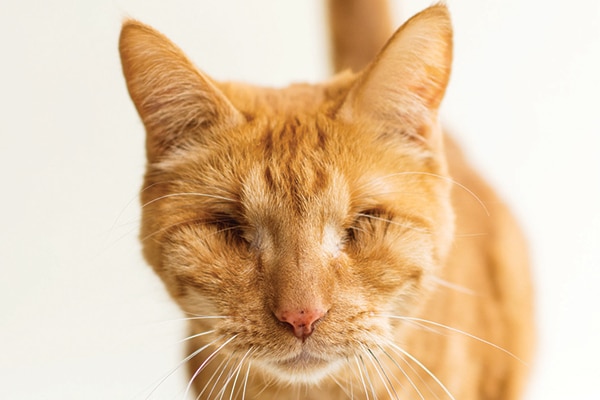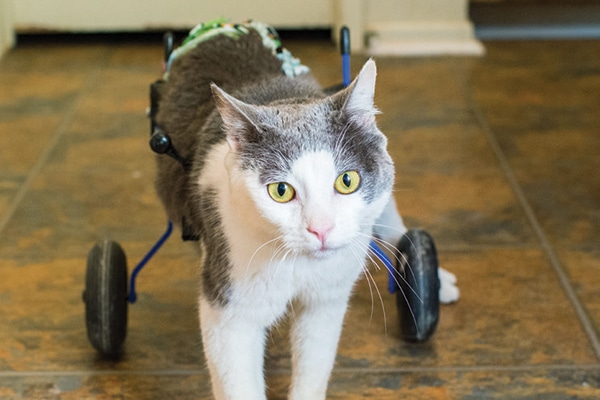What could be better than giving a loving home to a cat who has been overlooked merely because she is a little different? But living with special-needs cats is not without challenges. As a cat mom to a three-legged mischievous kitty named Smoochie, I know firsthand that a cat with physical challenges can come with behavior challenges, too.

Prepare your home if you are adopting special-needs cats
First, look around your home to make sure it’s a friendly environment for your cat’s special needs. In the case of Smoochie, she came to me at the age of 4 weeks with a severely damaged back leg. She was special because of her leg (which was later amputated) and because of her young age and tiny size. At the time, my other cats were all adults, so we had large and high litter boxes. That was just not going to work. To accommodate her bad leg and her tiny size, we used Fancy Feast boxes (the ones for a 24-pack), and they were just the right size for her. Now that she’s fully grown, three-legged Smoochie uses a Booda Dome litter box with a ramp that leads into the box, so it’s easy for her to climb inside.
One of my clients has a deaf cat named Crystal. Since Crystal cannot hear, my client has developed a sort of sign language to communicate with her. Pointing to her mouth tells Crystal it’s dinnertime, for example. Whenever I visited Crystal, I was instructed to approach her gently and touch her softly with a feather so as not to startle her by abruptly waking her. I have also worked with people who have blind cats. It’s important to let a blind kitty get oriented to her surroundings without making any changes to furniture placement. That is not to say you can never move your furniture, but while your blind cat is getting settled, leave everything in the same place. Adding different scents to each room also helps your blind cat learn his way around.
Special-needs cats and behavior issues
A special-needs cat may come with some emotional issues, depending on how long she has had special needs, was in a shelter or rescue and how well she has adapted to her challenge. Although my Smoochie has been with me since the age of 4 weeks, she has some behavior traits that I attribute to her missing leg and small stature. Smoochie is extremely protective of her food, for example. She lashes out at the larger cats at mealtime as I’m preparing the food bowls, putting them on notice that she eats first. The funny part: They actually respect her position as alpha female. At times, she’ll act the same way when she’s on my lap and another cat comes around. She knows it’s unacceptable behavior, so all I need to do is put my hand on her side, and she settles back down. Most of the time, though, she runs and plays and cuddles with the other cats just fine.
Recently, I was contacted by a woman who adopted a blind cat. The cat regularly missed the litter box. The cat was new to the household and still learning her way around. After discussing exactly where the litter box was (upstairs!), I suggested that she put a box on the first floor and bring the cat over to the box to let her know it was there. I also suggested the use of catnip spray around the box to lead her to it until she had memorized how to find it. Since then, there have been no more accidents.
Another issue blind cats face is boredom. They don’t get visual stimulation like sighted cats, so you need to provide them with tactile toys. Yes, blind cats DO play with toys! Textures, smells and shapes are important in giving your blind cat some playtime fun and stimulation. A little catnip helps, too!
Can special-needs cats live with other cats?
Absolutely! Introductions between them work the same as they would between any other cats — slow and supervised. A special-needs cat might be skittish, so build up her confidence. Start her off in a smaller room rather than giving her the run of the house to get her used to new surroundings and people. Talk to her in soothing tones, and offer praise and yummy treats to help her settle in and associate her new home with good things. Give her slow eye blinks — this signals friendship to your cat. Make sure she has places to “hide” like cubby holes and cat trees where she can observe her new surroundings undisturbed.
Playtime is always a good way to help a new cat feel good about her surroundings and build up her confidence. Before you know it, your cats will be buddies, spending their days playing and curling up for catnaps together, for the rest of their happy lives.
Thumbnail: Photography by Casey Elise Christopher.
Read more about adopting and rescuing cats on Catster.com:
- So a Stray Cat Has Adopted You — Now What?
- You Found a Stray Kitten — Here’s What to Do
- How to Recognize Adopt a Shelter Cat Month – If You Can’t Adopt a Cat
Rita Reimers’ Cat Behavior Coaching has helped many cat owners better understand their feline friends. Visit RitaReimers.com to read her cat behavior blog or book a cat behavior coaching session. Rita is also CEO/owner of JustForCatsPetSitting.com. Connect with her on Facebook and on Twitter at @theCatAnalyst.








